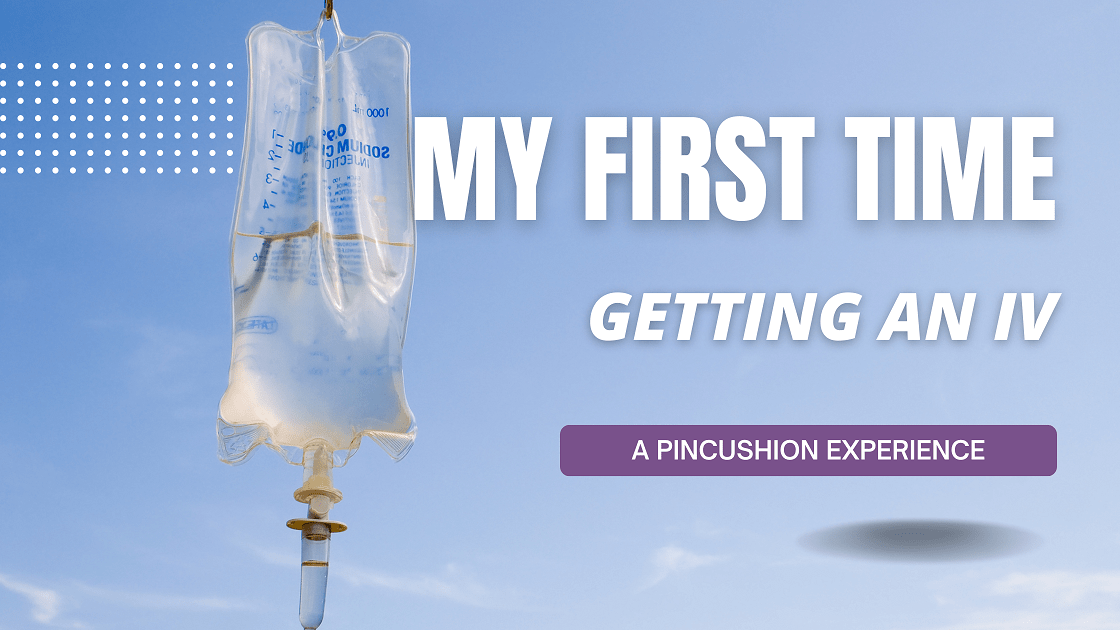A first I never wanted to experience – my first time getting an IV. Read all about my experience and perhaps it will help save you some pain.
The First Stick is Always the Hardest: My First Time Getting an IV
I had always somehow avoided getting an IV up until a couple of weeks ago when I landed in the emergency room. As someone terrified of needles, I had been dreading the prospect of having an IV inserted. However, when a nasty bout of uterine fibroids and severe dehydration landed me in the ER, it turned out an IV was necessary.
Deep down I knew it was coming when I was assigned to a room, and the nurse came in to take my vitals. Still, I couldn’t help but tense up when she said the fateful words “Ok, I’m going to place an IV now to give you fluids.”
As she tied the tourniquet around my arm and felt for a vein, I had to remember to breathe and stay still even though my heart raced inside.
I let out an involuntary wince when the needle first pierced my skin. The nurse apologized and said something to the effect of “First sticks can always be tricky, the veins move around.”
However, after a few more pokes, well, she couldn’t get it in.
That’s what she said! Jokes aside, this experience sucked!
Poking and Prodding Like a Pincushion
Getting an IV placed can sometimes be tricky if the nurse has difficulty locating a good vein.
Here is some advice on what to do if this happens:
Try to stay calm and relaxed even if the nurse needs to make multiple attempts. Tensing up can cause veins to narrow and be harder to access. Take slow, deep breaths and focus your mind elsewhere.
I was HORRIBLE AT THIS!
Speak up politely if the poking and prodding becomes truly unbearable. Politely state that you are feeling faint or in too much distress. A good nurse will recognize when to pause attempts before the patient becomes overly traumatized.
Again, I wasn’t doing well with this. I tried to be as polite as possible, but instead it just came out with a lot of tears as I begged her to stop.
Request that another experienced nurse or IV specialist come try inserting the IV. A second pair of eyes and hands can sometimes have better luck on difficult stick patients.
I got lucky in this respect because my first nurse gave up before I had to ask for someone else. She decided she couldn’t do it, and was called to another room just in the knick of time!
Ask if ultrasound guidance for the IV is available. Many hospitals now have portable ultrasound machines that can visually map out vein locations under the skin. This technology can guide the needle right to a viable vein.
Again, I got super lucky here that I didn’t have to ask. The second nurse came in with an ultrasound machine. And thank goodness because in truth, until that day I actually didn’t know there were ultrasound machines that could help nurses find a vein!
Remember that difficult IV insertion is common and no one’s fault. Whether due to dehydration, treatment history, or anatomy, some patients present challenges. Open communication with an emphasis on patience makes the process easier on both sides.
In my case, I was insanely dehydrated, and I wasn’t permitted to drink anything because we didn’t know if emergency surgery was going to be necessary for the fibroid situation I was dealing with or now.
Still, I understand that getting an IV line established is important for administering fluids and medications. Working as an understanding patient with your nurses leads to the best outcome. But do speak up if you feel further attempts start compromising your health or sanity! Healthy veins for the win.
This Was Different from Blood Draws in the Past
Look, I’m no stranger to needles, having to have my blood drawn many times before. However, somehow getting this IV felt much more intense than past blood draws.
With blood draws, there’s the familiar prick of the needle, but once it’s inside a vein the nurses usually don’t have to dig around too much.
The IV needle seemed thicker and I could feel it wiggling inside my arm as the nurse tried to position it correctly. Blood draws are usually a smooth process once the needle is in.
This IV insertion felt more like a journey to find just the right spot amidst my slippery veins.
While I understand both the IV and blood draws serve important medical purposes, I’ll take a simple blood draw over uncomfortably getting an IV any day if I have a say! However, in an emergency situation like this, I was grateful the nurses persisted until they secured the IV that eventually brought my body much needed relief.
“I’m in!”
It took a lot of effort, but finally I heard the magic words “I’m in!” as she got the IV in on the first try with the help of the ultrasound machine.
I felt a cool rush in my arm as she attached the saline pouch and the much-needed fluids began to flow into my vein. Even though it was uncomfortable and foreign at first, I had survived my first IV. Now that I know what to expect, I feel just a little bit braver for any medical adventures that come my way down the road. The first stick really was the hardest!
The Massive Bruise
Other than fluids, and a couple of new prescriptions, another thing I walked away with was a huge bruise on my arm from where the first nurse kept poking and prodding me. If this happens to you, here are some tips that were shared with me that may help heal a bruise from an IV more quickly:
Apply a cold compress. Ice wrapped in a towel and applied for 10-15 minutes a few times a day can help reduce inflammation and bruising. Don’t place ice directly on the skin.
Keep the area elevated. Try to avoid letting your arm with the IV bruise hang down by your side. Keeping it propped up above heart level will minimize pooling of blood and speed healing.
Use a gentle OTC pain relief cream. An over-the-counter cream with lidocaine or hydrocortisone could offer some comfort and anti-inflammatory benefits. Check that the ingredients are safe to use on broken skin.
Massage around the bruise lightly. Gentle massage can help stimulate blood flow and drainage of pooled blood from the area. Just avoid pressing directly on the tender bruise itself initially.
Try an OTC Arnica cream or gel. Many find that topical arnica, a homeopathic herb, can aid bruise healing. It may reduce swelling and discoloration.
Protect the skin from further injury. Be extra careful not to bump or injure the bruised area again until it has fully healed. Additional trauma will worsen existing bruising.
Allow two weeks of healing time. Like any deep bruise, an IV bruise needs time for your body to naturally reabsorb blood from the surrounding tissue and mend damaged capillaries. Patience pays off.
It’s been two weeks and my bruise on my arm has only now healed. It was a pretty rough experience overall, and it was tender to the touch for almost the entire two weeks.
See your doctor if pain persists longer than a few days or you notice signs of infection like pus or redness. Bruises hurt, but should gradually improve with time and care.
Welp, there you have it. My tale about my first time getting an IV. It’s an experience I genuinely hope I won’t have to have again anytime soon. If I have it my way, it’s one I won’t ever have to go through again. I will be keeping myself as hydrated as possible from now on though – just in case!

